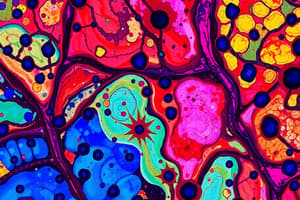Podcast
Questions and Answers
Which of the following best describes the function of the condenser in a bright-field microscope?
Which of the following best describes the function of the condenser in a bright-field microscope?
- It adjusts the distance between the eyepieces for comfortable viewing.
- It splits the light into different optical paths to enhance contrast.
- It magnifies the image produced by the objective lens.
- It collects and focuses a cone of light to illuminate the tissue slide. (correct)
How does fluorescence microscopy enhance the visualization of specific structures within a tissue sample?
How does fluorescence microscopy enhance the visualization of specific structures within a tissue sample?
- By using electron beams to achieve higher resolution imaging of cellular organelles.
- By employing phase shifts of light to enhance contrast in unstained samples.
- By using polarized light to reveal the crystalline structures in tissues.
- By utilizing fluorescent dyes that bind to specific molecules, emitting light when excited by UV or other light sources. (correct)
In the context of electron microscopy, what is the primary difference between Transmission Electron Microscopy (TEM) and Scanning Electron Microscopy (SEM)?
In the context of electron microscopy, what is the primary difference between Transmission Electron Microscopy (TEM) and Scanning Electron Microscopy (SEM)?
- TEM is used for live cell imaging, while SEM requires fixed samples.
- TEM provides information about the internal structure of the sample, while SEM provides information about the surface topography. (correct)
- TEM uses reflected electrons to create a 3D image, while SEM uses transmitted electrons for a 2D image.
- TEM uses light beams, while SEM uses electron beams.
Which of the following factors most significantly affects the resolving power of a microscope?
Which of the following factors most significantly affects the resolving power of a microscope?
Which of the following is a key principle behind phase-contrast microscopy that allows for the visualization of unstained cells?
Which of the following is a key principle behind phase-contrast microscopy that allows for the visualization of unstained cells?
What is the functional significance of the 'X-Y Translation Mechanism' in bright-field microscopy?
What is the functional significance of the 'X-Y Translation Mechanism' in bright-field microscopy?
Why is staining considered an essential step in preparing samples for observation under a standard light microscope?
Why is staining considered an essential step in preparing samples for observation under a standard light microscope?
How does confocal microscopy improve upon standard fluorescence microscopy in terms of image quality?
How does confocal microscopy improve upon standard fluorescence microscopy in terms of image quality?
In the context of fluorescence microscopy, what is the purpose of using both primary and secondary antibodies?
In the context of fluorescence microscopy, what is the purpose of using both primary and secondary antibodies?
If a bright-field microscope uses a 10X eyepiece and a 40X objective lens, what is the total magnification of the image observed?
If a bright-field microscope uses a 10X eyepiece and a 40X objective lens, what is the total magnification of the image observed?
What is the key limitation that prevents light microscopes from achieving the same level of resolution as electron microscopes?
What is the key limitation that prevents light microscopes from achieving the same level of resolution as electron microscopes?
Which component of a bright-field microscope is responsible for adjusting the amount of light that reaches the specimen?
Which component of a bright-field microscope is responsible for adjusting the amount of light that reaches the specimen?
What would be the primary challenge in using bright-field microscopy to examine living cells in their natural state?
What would be the primary challenge in using bright-field microscopy to examine living cells in their natural state?
How does the preparation of samples for Scanning Electron Microscopy (SEM) differ significantly from the preparation for Transmission Electron Microscopy (TEM)?
How does the preparation of samples for Scanning Electron Microscopy (SEM) differ significantly from the preparation for Transmission Electron Microscopy (TEM)?
What is the practical implication of the resolving power of the TEM being 3 nm?
What is the practical implication of the resolving power of the TEM being 3 nm?
Which type of microscopy would be most appropriate for visualizing the three-dimensional structure of the protein on the surface of a cell?
Which type of microscopy would be most appropriate for visualizing the three-dimensional structure of the protein on the surface of a cell?
In fluorescence microscopy, if a tissue section is irradiated with ultraviolet (UV) light, what determines the color of the emitted light that is observed?
In fluorescence microscopy, if a tissue section is irradiated with ultraviolet (UV) light, what determines the color of the emitted light that is observed?
What is the primary reason for using a vacuum in electron microscopy?
What is the primary reason for using a vacuum in electron microscopy?
How does the use of a measuring graticule enhance the functionality of a microscope?
How does the use of a measuring graticule enhance the functionality of a microscope?
Which of the following best describes the role of the 'revolving nosepiece' on a bright-field microscope?
Which of the following best describes the role of the 'revolving nosepiece' on a bright-field microscope?
Flashcards
Light Microscope
Light Microscope
Uses visible light and optical lenses to magnify tissue for routine histology.
Electron Microscope
Electron Microscope
Uses electron beams for higher resolution to observe fine details like cell membranes and organelles.
Fluorescence Microscopy
Fluorescence Microscopy
Highlights specific structures using fluorescent dyes, useful for studying proteins and DNA.
Confocal Microscopy
Confocal Microscopy
Signup and view all the flashcards
Eyepiece
Eyepiece
Signup and view all the flashcards
Interpupillary Adjustment
Interpupillary Adjustment
Signup and view all the flashcards
Binocular Tubes
Binocular Tubes
Signup and view all the flashcards
Head
Head
Signup and view all the flashcards
Beamsplitter
Beamsplitter
Signup and view all the flashcards
Measuring Graticule
Measuring Graticule
Signup and view all the flashcards
Revolving Nosepiece
Revolving Nosepiece
Signup and view all the flashcards
Objective Lenses
Objective Lenses
Signup and view all the flashcards
Specimen Holder
Specimen Holder
Signup and view all the flashcards
Mechanical Stage
Mechanical Stage
Signup and view all the flashcards
Condenser
Condenser
Signup and view all the flashcards
Field Lens & Diaphragm
Field Lens & Diaphragm
Signup and view all the flashcards
Collector Lens
Collector Lens
Signup and view all the flashcards
Tungsten Halogen Lamp
Tungsten Halogen Lamp
Signup and view all the flashcards
Base
Base
Signup and view all the flashcards
Stand
Stand
Signup and view all the flashcards
Study Notes
Types of Microscopes
- Light microscopes utilize visible light and optical lenses to magnify tissues, ideal for routine histology.
- Electron microscopes employ electron beams, providing higher resolution for observing cell membranes and organelles.
- Staining and microscopy are essential for detailed tissue analysis, helping identify structural abnormalities, diagnose diseases, and conduct medical research.
Light Microscope (Bright-Field)
- The condenser narrows the light beam, reducing scattering.
- The diaphragm controls and regulates the electricity.
- Eyepiece is that lens through which the user looks.
- Interpupillary Adjustment adjusts the distance between the two eyepieces.
- Binocular Tubes hold eyepieces and allow for alignment.
- Head connects eyepieces to the microscope.
- Beamsplitter splits the light for different optical paths.
- Measuring Graticule is a scale inside the eyepiece for measurements.
- Revolving Nosepiece holds multiple objective lenses for rotation.
- Objective Lenses magnify specimens at different levels.
- Specimen Holder secures the slide.
- Mechanical Stage moves the slide.
- Condenser focuses light onto the specimen.
- Field Lens & Diaphragm controls and directs light.
- Collector Lens focuses light from the lamp.
- Tungsten Halogen Lamp is the light source.
- Base provides the foundation.
- Stand supports the structure.
- On/Off Switch & Illumination Intensity Control adjusts brightness.
- X-Y Translation Mechanism allows precise stage movement.
- Bright-field microscopy is the most common and cheapest light microscopy.
- Stained tissue is examined with ordinary light passing through the preparation.
- The microscope includes an optical system and mechanisms to move and focus the specimen.
- A condenser collects and focuses light, illuminating the tissue slide.
- Objective lenses enlarge and project the image toward the eyepiece.
- Eyepieces (oculars) magnify the image another 10X, yielding total magnifications of 40X, 100X, or 400X.
Fluorescence Microscopy
- Fluorescence occurs when cellular substances are irradiated by light of a proper wavelength, emitting light with a longer wavelength.
- In fluorescence microscopy, tissue sections are irradiated with ultraviolet (UV) light.
- The emission is in the visible portion of the spectrum.
- Fluorescent substances appear bright on a dark background.
- The instrument has a UV or other light source and filters to select wavelengths emitted by the substances.
- The primary antibody has limited fluorophore compared to the secondary antibody.
- The secondary antibody loads more fluorophore from the protein, amplifying the signal for easier visualization.
- Cultured cells are grown in dishes (incubator), and viewed to visualize immunostained sections.
- Filamentous proteins concentrate under the plasma lamina.
- Cell’s life in cultures depends on their social interactions and communication.
Phase-Contrast Microscopy
- For studying unstained cells and tissue sections (colorless; similar optical densities).
- It has a lens system that produces visible images from transparent objects.
- It is used with living, cultured cells.
- Light changes speed when passing through cellular and extracellular structures with different refractive indices, causing them to appear lighter or darker in relation to each other.
Electron Microscope
- Interaction of tissue with a beam of electrons - reflected, absorbed, or passed through.
- TEM involves the electron beam passing through the tissue.
- Very high magnification achieved.
- Very thin sections, 40-90 nm, are needed.
- The electron beam interacts with tissue, producing black, white, and shades of gray images.
- SEM involves the electron beam not passing through the tissue.
- The surface of cells and tissue is coated with heavy metals (gold) which reflect the electrons.
- SEM then produces 3D images that record the specimen topography.
Resolution
- Resolution defines how finely detailed the images are.
- Resolving power is the smallest distance between two structures at which they can be seen as separate objects.
- The maximal resolving power of a light microscope is approximately 0.2 µm, which allows one to see clear images magnified 1000-1500 times.
- Objects smaller than 0.2 µm (like single ribosomes or cytoplasmic microfilaments) cannot be distinguished.
- A microscope's resolving power determines the quality of the image, clarity, and richness of detail.
- Resolving power depends mainly on the quality of its objective lens.
- Magnification is of value only when accompanied by high resolution.
- Resolving of TEM is 3 nm because the electron wavelength is shorter than that of light.
Studying That Suits You
Use AI to generate personalized quizzes and flashcards to suit your learning preferences.




